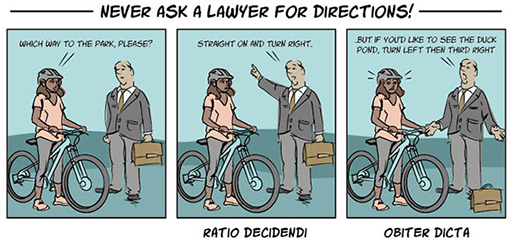8.1 Ratio decidendi and obiter dicta
The first factor that influences how persuasive a rule is whether the rule was key to the outcome, or whether it was just a speculative comment by the judge. If the rule was key, then it can be binding on later courts, whereas speculative comments are only persuasive and do not need to be followed. It is therefore necessary to distinguish between them. The two types of rules also tend to be called by their Latin names.
The binding type of rule is one that actually decides the case. This is known in Latin as the ‘ratio decidendi’, or reason for the decision. Sometimes it is shortened just to ‘ratio’. All cases must have a ratio because it is the rule that the judge applies to decide the case and also the judge must explain this in their reasons. For example, in the circumstances of the case of MacLennan v MacLennan,Footnote 4 if the judge had decided that the partner who became pregnant by artificial insemination had not committed adultery, then the ratio might be something like: ‘a married woman who becomes pregnant through self-impregnation does not commit adultery’. The ratio is obviously the most important part of a case.
There is no easy way to identify what part of a case is the ratio (Holland and Webb, 2019). Court reporters such as those who work for the ICLR will try and identify the ratio in the summary of the case, but the reporters do not always get the ratio right. Judges themselves rarely try to highlight the ratio in their own decisions, but they may use the phrase when discussing what part of a previous case might be the ratio. As a result, spotting the ratio is a skill that comes with practice and familiarity with case reports.
The second type of rule is the one that is not binding. Judges sometimes like to offer comments about hypothetical and related circumstances that they do not have to decide. They do this to explain their thinking and check that the rules that they are applying make sense. This is also known by its Latin name of ‘obiter dictum’ meaning an incidental comment. Sometimes this is also shortened to just ‘obiter’. Rules that are obiter are not binding on later judges, but they may be persuasive. For example, in the case of MacLennan v MacLennan, when giving reasons, the judge might have said something like: ‘Of course, and hypothetically speaking, it might be the case that a married man might offer his sperm to somebody other than his wife for reproductive purposes and without having intercourse. While these are not the facts before the court today, my view is that those circumstances would not amount to adultery either’. If there was a later case that happened to fit those facts, then the earlier judge’s comments would not be binding, but they would be influential. Exactly how influential depends on how senior the court is. Obiter from a judge in the Supreme Court carries a lot more weight than obiter from an adjudicator in the Traffic Penalty Tribunal.
Activity 5 Ratio or obiter?
Consider the following legal issue:
The issue in the case of Gillick v West Norfolk and Wisbech AHA Footnote 5 was set out by Lord Fraser as follows: ‘My Lords, the main question in this appeal is whether a doctor can lawfully prescribe contraception for a girl under 16 years of age, without the consent of her parents’ (p.162).
Below are some extracts from the speeches (speeches are what the judgments used to be called in the House of Lords) of the House of Lords. For each extract, try to distinguish between what is ratio decidendi and what is obiter dictum. To do this, you need to decide whether they are directly deciding the legal issue (in which case it is ratio), or whether they are speculating on a slightly different issue (in which case it is obiter). This is a difficult task, so do not worry if you do not get it right first time.
The second factor that determines how influential a rule in a case is, is how senior the court is. Or to put it in comedy terms of the ‘Class sketch’ (see Figure 10 overpage), if a court looks down on other courts, it is more influential than a court that looks up to other courts.
Footnotes
- 4 MacLennan v MacLennan [1958] SC 105.Back to main text
- 5 Gillick v West Norfolk and Wisbech AHA [1986] AC 112.Back to main text

